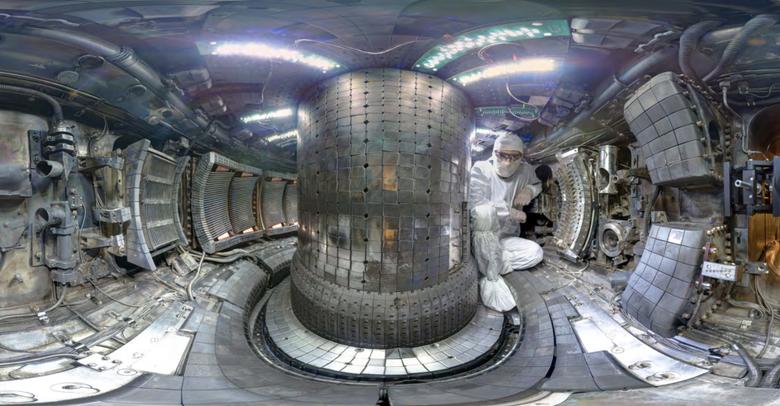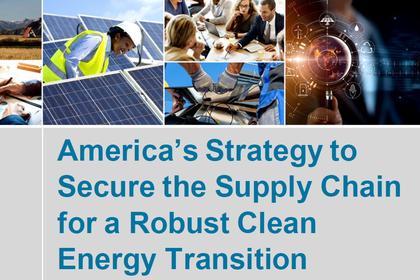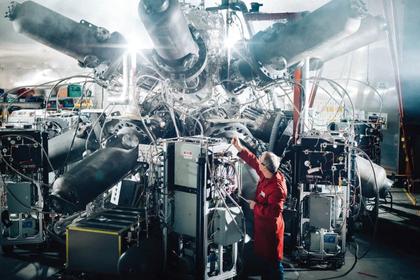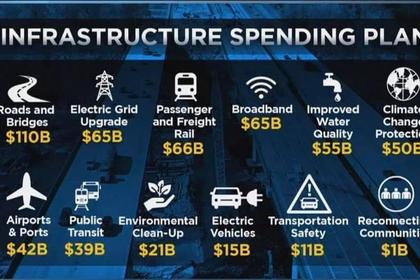
U.S. FUSION ACCELERATION

THE WHITE HOUSE - MARCH 15, 2022 - The Biden-Harris Administration is focused on building a clean energy future that creates good-paying jobs, lowers energy bills, and supports a path toward U.S. energy independence by manufacturing and deploying clean energy for the benefit of all Americans. President Biden is doubling down on the strategy that the best way to bring down costs is to speed up – not slow down – our transition to clean energy. He has pledged to use every tool available to reduce pain at the pump while accelerating the already-available, cheap, clean energy solutions today. Capturing the economic opportunity from clean energy and energy efficiency improvements will lower utility bills for families and businesses, address the climate crisis, and help ensure our communities breathe clean air.
As we sprint to deploy today’s clean energy, we are also investing in new options for the future that will provide U.S. workers the opportunity to build the new technologies and position America to be energy leaders in the 21st century.
Today, the Biden-Harris Administration announced that it is developing a bold decadal vision to accelerate fusion – a clean energy technology that uses the same reaction that powers the Sun and stars.
Fusion energy – produced by combining atoms to create heavier ones – has long been recognized to have great potential as a safe, abundant, zero-carbon source of reliable electricity. Once developed, fusion will use a combination of lithium and hydrogen as fuel, and create no long-lived radioactive waste. Fusion will also provide a combined source of thermal energy and power for hydrogen production, industrial heat, carbon capture, and desalination.
Fusion could provide abundant, reliable, carbon-free energy to advance President Biden’s goal to get to net-zero emissions by 2050, while increasing energy security and enhancing America’s technological competitive edge. Commercial fusion energy technology has the potential to revolutionize the energy industry, helping combat the climate crisis while meeting the growing electricity needs of the U.S. and the world.
Because of these benefits, the U.S. has invested for decades in its own fusion program led by the Department of Energy National Laboratories, as well as in major international collaborations. Today, a major focus of the U.S. research program is ITER, a 35-country collaboration where an international team of scientists is working together to build the world’s largest tokamak, a magnetic fusion device that has been designed to prove the feasibility of fusion power. Participation in this important international scientific collaboration has yielded significant additional benefits, such as increasing access to experienced personnel from other countries, data and modeling software, component design, peer review, and facilities with capabilities unavailable in the U.S.
Seven decades of public funding for fusion research have led to major recent scientific advances and rapid growth in private investment. Now is the time to accelerate development of commercial fusion energy, while ensuring that the benefits of fusion are shared in an equitable and just way across our communities.
The Biden-Harris Administration views fusion as a potential game-changing clean energy technology, and is taking the following steps to accelerate viable commercial fusion energy:
- Holding a White House Fusion Summit on March 17, 2022, co-sponsored by the White House Office of Science and Technology Policy (OSTP) and the U.S. Department of Energy (DOE), to convene a broad group of stakeholders to initiate discussions exploring the promise of the technology and the remaining challenges. This input will inform the development of a bold decadal strategy to accelerate the realization of commercial fusion. Further workshops in the upcoming months will build on these initial discussions.
- The DOE will launch an agency-wide initiative, coordinating across program offices, to develop a decadal strategy to accelerate the viability of commercial fusion energy in partnership with the private sector. The 2021 National Academies of Sciences, Engineering, and Medicine (NASEM) report Bringing Fusion to the U.S. Grid serves as a guiding document for the new initiative. The initiative will be facilitated by a new DOE Lead Fusion Coordinator reporting to the Undersecretary for Science and Innovation.
Fusion Science and Technology are at a Turning Point
A fusion reaction in which more energy is produced than is consumed always seemed to be decades in the future. Recent advances, building on 70 years of groundbreaking fusion science and technology by DOE National Laboratories and other agencies, universities, and industry, demonstrate that we are closer than ever to a viable reaction. Just in the past year, there have been many technical achievements reported in the media. For example:
- a privately-funded U.S. fusion company demonstrated its prototype 20-tesla high-temperature-superconducting magnet, opening up an exciting new high-field, compact approach to commercial fusion energy,
- the first central-solenoid magnet was delivered for ITER, illustrating fusion-scale manufacturing capability of U.S. industry,
- the Joint European Torus (JET) in the UK doubled its 24-year-old record with a five-second, high-power pulse, limited only by the experimental hardware and not the plasma stability,
- Lawrence Livermore National Laboratory’s National Ignition Facility (NIF) in California achieved an energy yield eight times higher than its previous record and reached the cusp of ignition, providing us a second fusion approach with similar physics performance as the tokamak, and
- China’s Experimental Advanced Superconducting Tokamak (EAST) sustained fusion reactions for 17 minutes at 126 million degrees Fahrenheit – five times hotter than the sun.
The market pull for commercial fusion is also growing rapidly. In 2021, the private sector invested over $2.5 billion in fusion technology development (with the overwhelming majority focused on U.S. fusion companies). Further, fusion companies are now building several large experimental facilities in the U.S., with the aspiration of demonstrating a proof-of-concept for several different types of fusion power plants before the end of the decade.
As a result of these developments and others, scientific advisory groups such as the DOE Fusion Energy Sciences Advisory Committee and NASEM agree that now is the time to accelerate commercial fusion energy.
The Race is On for Commercial Fusion
While recent breakthroughs by the fusion energy research community represent considerable progress toward achieving commercial fusion, significant science and technology challenges remain. Most importantly, we have yet to demonstrate we can exceed the break-even point, where the fusion system releases more energy than is needed to create the conditions where the fusion reactions occur. A viable fusion power plant also requires consistent, safe, and reliable operation, as well as improved stable plasma containment, fuel-cycle sufficiency including breeding tritium (an isotope of hydrogen), materials that can withstand continuous operation, integrated heat-exhaust solutions, and coupling the fusion device to advanced thermal extraction and power conversion systems.
The U.S. government has an extensive science and technology infrastructure, including the experienced researchers and world-class scientific and computational facilities that will be required to realize this vision. It is therefore uniquely positioned to help address key technical barriers to realizing commercial fusion. International competition is rapidly increasing. Countries such as China and the UK are making major investments to expand their fusion R&D efforts with the goal of demonstrating viable fusion energy production.
The U.S. government can help clear the path to commercialization by developing a risk-informed regulatory framework, addressing safety and security concerns, enabling technology exports through international regulatory harmonization and effective export controls, supporting essential supply chains, actively engaging the U.S. public, and providing education and training to build a diverse workforce.
DOE and the private sector are pursuing a variety of approaches to fusion, which diversifies scientific and technical risk and potential market impact. Thus, the large private investments in the U.S. fusion industry provide an essential means of amplifying the public dollars to create the U.S. commercial fusion industry. Additional key benefits of Public-Private Partnerships (PPPs) for technology research, development, and demonstration (RD&D) include:
- ensuring alignment with commercial market pull,
- reducing risk and cost to the taxpayer,
- harnessing the combined strengths of the public and private sectors and other essential stakeholders,
- creating good jobs in new industries, and
- ensuring that U.S. scientific and technical innovations translate into U.S. leadership in commercial fusion energy.
Of the more than 30 fusion companies in the world, two-thirds are based in the U.S., and most were founded in the last decade. U.S. government action on fusion signals our ambition to work together to grow the U.S. private fusion industry. By partnering with these companies, we have an opportunity to keep these companies growing within our borders and cement U.S. technological leadership on fusion.
The White House Fusion Summit
OSTP and DOE will co-host a White House Fusion Summit on Developing a Bold Decadal Vision for Commercial Fusion Energy on March 17, 2022. The event will convene fusion energy leaders from government, industry, academia, and other stakeholder groups to:
- showcase progress made on fusion in the DOE and the private sector,
- educate the public, U.S. government, and private groups about the need for an updated strategy to realize fusion energy generation,
- provide the opportunity for a variety of fusion stakeholders, including energy justice and environmental advocates, to voice their existing and anticipated needs, and
- understand how the U.S. government can best accelerate the development and demonstration of fusion pilot facilities.
Equity and inclusion are central to the Biden-Harris Administration’s approach to energy innovation, and a key objective of this event is to bring a wide range of voices to the table for an inclusive and early conversation about the future of fusion technology.
Key topics of discussion at the event include:
- describing the state of fusion technology and its benefits to the climate, energy security, and U.S. global competitiveness,
- defining the steps needed to build a fusion industry that supports energy and environmental justice, energy ethics, environmental sustainability, diversity, and effective public engagement, and
- outlining the fusion industry’s visions and challenges, and how the U.S. government can accelerate fusion technology.
A full event agenda is available here.
We stand at a juncture with an opportunity to reap the benefits of decades of investments. Fusion is a potential carbon-free, abundant source of clean energy that will bolster American leadership, strengthen energy security, and enable sustained energy independence. A vibrant U.S. fusion program will also enable the U.S. to take advantage of the participation in the ITER Project and explore new international collaborations to further accelerate the development of fusion energy.
More announcements will be forthcoming as we continue to take steps towards a comprehensive decadal vision and strategy for commercial fusion.
-----
Earlier:












